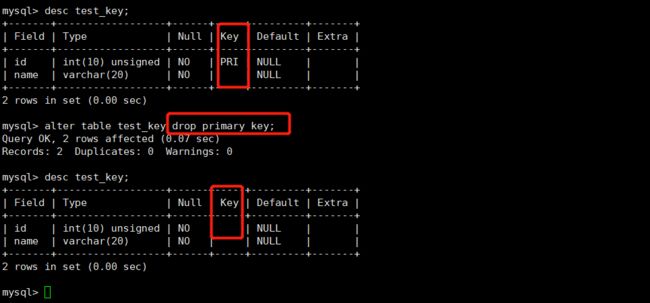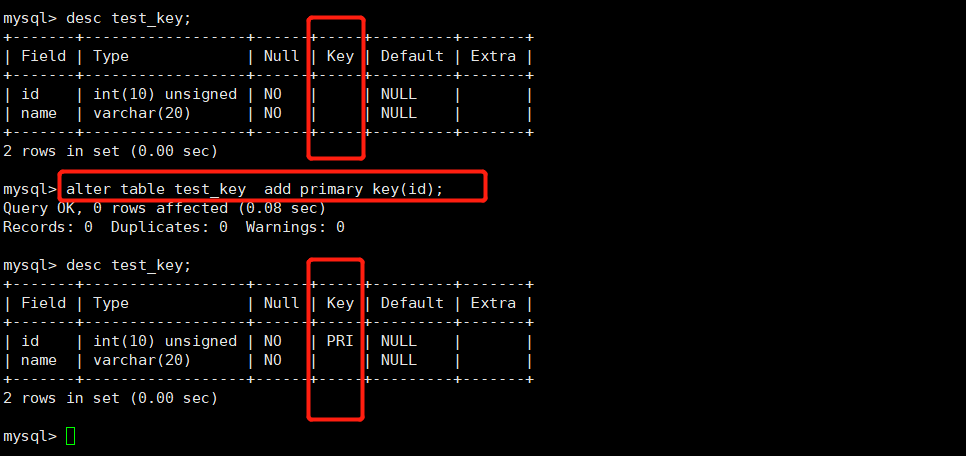【MySql】表的约束
文章目录
- 概述
- 空属性 not null
- 默认值default
- 列描述comment
- zerofill
- 主键 primary key
- 自增长auto_increment
- 唯一键unique
- 外键foreign key
- 综合案例
概述
真正约束字段的是数据类型,但是数据类型约束很单一,需要有一些额外的约束,更好的保证数据的合法性,从业务逻辑角度保证数据的正确性。比如有一个字段是email,要求是唯一的。表中一定要有各种约束,通过约束,让我们未来插入数据库表中的数据是符合预期的。约束的本质是通过技术收到逼迫程序员插入正确的数据,反过来,站在mysql的视角,凡是插入进来的数据,都是符合数据约束的。约束的最终目标:保证数据的完整性和可预期性所以需要更多的约束。
表的约束很多,这里主要介绍如下几个: null/not null,default, comment, zerofill,primarykey,auto_increment,unique key 。
空属性 not null
两个值:null(默认的)和not null(不为空)
数据库默认字段基本都是字段为空,但是实际开发时,尽可能保证字段不为空,因为数据为空没办法参与运算。
站在正常的业务逻辑中:
如果班级没有名字,你不知道你在哪个班级
如果教室名字可以为空,就不知道在哪上课
所以我们在设计数据库表的时候,一定要在表中进行限制,满足上面条件的数据就不能插入到表中。这就是“约束”。
mysql> create table if not exists myclass(
-> class_name varchar(20) not null,
-> class_room varchar(20) not null,
-> other varchar(20)
-> );
Query OK, 0 rows affected (0.04 sec)
现在插入数据:
mysql> insert into myclass (class_name,class_room,other) values ('六年级1班','101教室',''普通班');
Query OK, 1 row affected (0.00 sec)
mysql> insert into myclass (class_name,class_room) values ('六年级1班','101教室');
Query OK, 1 row affected (0.00 sec)
而对于not null,非空约束,下面的这些都不能插入:
mysql> insert into myclass (class_name) values ('六年级1班');
ERROR 1364 (HY000): Field 'class_room' doesn't have a default value
mysql> insert into myclass (class_name,class_room) values ('六年级1班',NULL);
ERROR 1048 (23000): Column 'class_room' cannot be null
mysql> insert into myclass (class_name,class_room) values (NULL,NULL);
ERROR 1048 (23000): Column 'class_name' cannot be null
mysql>
默认值default
默认值:某一种数据会经常性的出现某个具体的值,可以在一开始就指定好,在需要真实数据的时候,用户可以选择性的使用默认值。
举个例子:
mysql> create table if not exists t13(
-> name varchar(20) not null,
-> age tinyint unsigned default 18,
-> gender char(1) default '男'
-> );
Query OK, 0 rows affected (0.03 sec)
mysql> insert into t13(name,age,gender) values ('张三',19,'女');
Query OK, 1 row affected (0.01 sec)
mysql> insert into t13(name) values ('李四');
deault:如果设置了,用户将来插入,有具体的数据就用,没有就默认
如果我们没有明确指定一列要插入,用的是default,如果建表中,对应列默认没有设置default值,无法直接插入。
举个例子:
mysql> create table t14(
-> name varchar(20) not null,
-> age tinyint default 18,
-> gender char(1) not null default '男'
-> );
Query OK, 0 rows affected (0.05 sec)
mysql> insert into t14 (name,age,gender) values (NULL,20,'男');
ERROR 1048 (23000): Column 'name' cannot be null
mysql> insert into t14 (name,age,gender) values (20,'男');
ERROR 1136 (21S01): Column count doesn't match value count at row 1
mysql> insert into t14 (name,age,gender) values ('张三',20,NULL);
ERROR 1048 (23000): Column 'gender' cannot be null
mysql> insert into t14 (name,age) values ('张三',20);
Query OK, 1 row affected (0.00 sec)
default和NOT NULL不冲突,而是互相补充的,当用户想插入的时候,无非就是NULL或者合法数据,当用户忽略这一列的时候,使用默认值(前提是设置了默认值),如果没有设置,直接报错。
列描述comment
列描述:comment,没有实际含义,专门用来描述字段,会根据表创建语句保存,用来给程序员或DBA来进行了解,。
mysql> create table if not exists t16 (
-> name varchar(20) not null comment '这个是用户名',
-> age tinyint unsigned default 18 comment '这个是用户年龄',
-> gender char(1) default '男' comment '这个是用户性别'
-> );
Query OK, 0 rows affected (0.04 sec)
--注意:not null和defalut一般不需要同时出现,因为default本身有默认值,不会为空
通过desc查看不到注释信息 :
通过show可以看到:
zerofill
创建一个表:
mysql> create table if not exists t17 (
-> a int unsigned not null,
-> b int unsigned not null
-> );
Query OK, 0 rows affected (0.03 sec)
可以看到int(10),这个代表什么意思呢:其实没有zerofill这个属性,括号内的数字是毫无意义的。a和b列就是前面插入的数据
但是对列添加了zerofill属性后,显示的结果就有所不同了。修改t17这个表的属性:
mysql> alter table t17 modify b int unsigned zerofill not null;
Query OK, 0 rows affected (0.07 sec)
Records: 0 Duplicates: 0 Warnings: 0
对b列添加了zerofill属性,再进行查找,返回如下结果
b的值由原来的1变成0000000001,这就是zerofill属性的作用,如果宽度小于设定的宽度(这里设置的是10),自动填充0。要注意的是,这只是最后显示的结果,在MySQL中实际存储的还是2.
我们可以用hex函数来证明 :hex:把一个数字变成十六进制
mysql> insert into t17 values (100,200);
Query OK, 1 row affected (0.00 sec)
当然,也可以直接设置更改大小:
mysql> alter table t17 modify b int(4) unsigned zerofill;
Query OK, 0 rows affected (0.01 sec)
Records: 0 Duplicates: 0 Warnings: 0
mysql> select * from t17;
为什么默认是10:足以把整数的数据位表示出来。
主键 primary key
主键:primary key用来唯一的约束该字段里面的数据,不能重复,不能为空,一张表中最多只能有一个。但是并不意味着一个表中的主键,只能添加给一列。一个主键可以被添加到一列,或者多列上
主键;主键所在的列通常是整数类型
- 创建表的时候直接在字段上指定主键
mysql> create table if not exists test_key (
-> id int unsigned primary key comment '这个是学生的学号',
-> name varchar(20) not null
-> );
Query OK, 0 rows affected (0.03 sec)
- 主键约束:主键对应的字段中不能重复,一旦重复,操作失败
mysql> insert into test_key values (1,'张飞');
Query OK, 1 row affected (0.01 sec)
mysql> insert into test_key values (1,'刘备');
ERROR 1062 (23000): Duplicate entry '1' for key 'PRIMARY'
- 删除主键
alter table 表名 drop primary key;
- 当表创建好以后但是没有主键的时候,可以再次追加主键
alter table 表名 add primary key(字段列表)
- 复合主键
在创建表的时候,在所有字段之后,使用primary key(主键字段列表)来创建主键,如果有多个字段作为主键,可以使用复合主键。
举个例子:
mysql> create table pick_course(
-> id int unsigned,
-> course_id int unsigned comment '课程编号',
-> score tinyint unsigned comment '课程分数',
-> primary key (id,course_id)
-> );
Query OK, 0 rows affected (0.03 sec)
mysql> insert into pick_course values(1235,50,86);
Query OK, 1 row affected (0.01 sec)
mysql> insert into pick_course values(1235,50,96);
ERROR 1062 (23000): Duplicate entry '1235-50' for key 'PRIMARY'
自增长auto_increment
auto_increment:当对应的字段,不给值,会自动的被系统触发,系统会从当前字段中已经有的最大值+1操作,得到一个新的不同的值。通常和主键搭配使用,作为逻辑主键。
自增长的特点:
任何一个字段要做自增长,前提是本身是一个索引(key一栏有值)
自增长字段必须是整数
一张表最多只能有一个自增长
mysql> create table if not exists t21(
-> id int unsigned primary key auto_increment,
-> name varchar(20) not null
-> );
Query OK, 0 rows affected (0.02 sec)
现在我们给name插入一些值:
mysql> insert into t21 (name) values ('a');
Query OK, 1 row affected (0.00 sec)
mysql> insert into t21 (name) values ('b');
Query OK, 1 row affected (0.01 sec)
可以发现,对于id是自增长的。
对于自增长:默认是从1开始插入的,如果默认插入了一个值作为起始值,则从这个起始值加1开始
所以我们在创建表的时候可以给自增长设置一个起始值:
mysql> create table t22(
-> id int unsigned primary key auto_increment,
-> name varchar(20) not null
-> )auto_increment=500;
Query OK, 0 rows affected (0.03 sec)
mysql> insert into t22 (name) values ('a');
Query OK, 1 row affected (0.01 sec)
mysql> insert into t22 (name) values ('b');
Query OK, 1 row affected (0.00 sec)
mysql> insert into t22 (name) values ('c');
Query OK, 1 row affected (0.00 sec)
唯一键unique
一张表中有往往有很多字段需要唯一性,数据不能重复,但是一张表中只能有一个主键:唯一键就可以解决表中有多个字段需要唯一性约束的问题。
唯一键的本质和主键差不多,唯一键允许为空,而且可以多个为空,空字段不做唯一性比较。
关于唯一键和主键的区别:
我们可以简单理解成**,主键更多的是标识唯一性的。而唯一键更多的是保证在业务上,不要和别的信息出现重复。**
举个例子:
mysql> create table stu(
-> id char(20) unique comment '这是一个唯一键',
-> name varchar(32) not null
-> );
Query OK, 0 rows affected (0.02 sec)
mysql> insert into stu (id,name) values ('12345','张三');
Query OK, 1 row affected (0.01 sec)
mysql> insert into stu (id,name) values ('12345','李四');
ERROR 1062 (23000): Duplicate entry '12345' for key 'id'
mysql> insert into stu (id,name) values (NULL,'李四');
Query OK, 1 row affected (0.00 sec)
对于唯一键,NULL时可以插入。
我们选择某一列作为主键,但是并不排除其他属性不需要维护,可能需要用到唯一键来限定,选择其他列作为唯一键,与主键配合起来,能够保证一些数据冲突。
比如在公司,我们需要一个员工管理系统中有一个员工表,员工表中有两列信息,一个身份证号码,一个是员工工号,我们可以选择身份号码作为主键。
而我们设计员工工号的时候,需要一种约束:而所有的员工工号都不能重复。
具体指的是在公司的业务上不能重复,我们设计表的时候,需要这个约束,那么就可以将员工工号设计成为唯一键。
一般而言,我们建议将主键设计成为和当前业务无关的字段,这样,当业务调整的时候,我们可以尽量不会对主键做过大的调整。
外键foreign key
外键用于定义主表和从表之间的关系:外键约束主要定义在从表上,主表则必须是有主键约束或unique约束。当定义外键后,要求外键列数据必须在主表的主键列存在或为null
foreign key (字段名) references 主表(列)
创建表student:
mysql> create table if not exists student(
-> id int unsigned primary key auto_increment,
-> name varchar(20) not null,
-> telphone varchar(32) not null,
-> class_id int
-> );
创建表class:
mysql> create table if not exists class(
-> id int primary key,
-> name varchar(32) not null
-> );
Query OK, 0 rows affected (0.03 sec)
学生表为从表,班级表是主表,class_id就是外键,需要考虑关联和约束关系
插入学生信息的班级必须存在。不存在就不能插入。
所以我们需要新建一个从表student并设置外键:
mysql> create table if not exists student(
-> id int unsigned primary key,
-> name varchar(20) not null,
-> telphone varchar(32) unique key,
-> class_id int,
-> foreign key(class_id) references class(id)
-> );
Query OK, 0 rows affected (0.04 sec)
查看班级信息:
查看学生信息:
mysql> insert into student values (101,'李四','12346',2);
Query OK, 1 row affected (0.00 sec)
mysql> insert into student values (102,'王五','12347',3);
ERROR 1452 (23000): Cannot add or update a child row: a foreign key constraint fails (`test_db`.`student`, CONSTRAINT `student_ibfk_1` FOREIGN KEY (`class_id`) REFERENCES `class` (`id`))
mysql> delete from class where id=1;
ERROR 1451 (23000): Cannot delete or update a parent row: a foreign key constraint fails (`test_db`.`student`, CONSTRAINT `student_ibfk_1` FOREIGN KEY (`class_id`) REFERENCES `class` (`id`))
理解外键约束
理论上,上面的例子,我们不创建外键约束,就正常建立学生表,以及班级表,该有的字段我们都有。此时,在实际使用的时候,可能会出现什么问题?
有没有可能插入的学生信息中有具体的班级,但是该班级却没有在班级表中?比如学校只开了信息100班,信息101班,但是在上课的学生里面竟然有信息102班的学生(这个班目前并不存在),这很明显是有问题的。
因为此时两张表在业务上是有相关性的,但是在业务上没有建立约束关系,那么就可能出现问题。
解决方案就是通过外键完成的。建立外键的本质其实就是把相关性交给mysql去审核了,提前告诉mysql表之间的约束关系,那么当用户插入不符合业务逻辑的数据的时候,mysql不允许你插入。
综合案例
有一个商店的数据,记录客户及购物情况,有以下三个表组成:
商品goods(商品编号goods_id,商品名goods_name, 单价unitprice, 商品类别category, 供应商provider)
客户customer(客户号customer_id,姓名name,住址address,邮箱email,性别sex,身份证card_id)
购买purchase(购买订单号order_id,客户号customer_id,商品号goods_id,购买数量nums)
要求:
每个表的主外键
客户的姓名不能为空值
邮箱不能重复
客户的性别(男,女)
-- 选择数据库
create table if not exists goods
(
goods_id int primary key auto_increment comment '商品编号',
goods_name varchar(32) not null comment '商品名称',
unitprice int not null default 0 comment '单价,单位分',
category varchar(12) comment '商品分类',
provider varchar(64) not null comment '供应商名称'
);
create table if not exists customer
(
customer_id int primary key auto_increment comment '客户编号',
name varchar(32) not null comment '客户姓名',
address varchar(256) comment '客户地址',
email varchar(64) unique key comment '电子邮箱',
sex enum('男','女') not null comment '性别',
card_id char(18) unique key comment '身份证'
);
create table if not exists purchase
(
order_id int primary key auto_increment comment '订单号',
customer_id int comment '客户编号',
goods_id int comment '商品编号',
nums int default 0 comment '购买数量',
foreign key (customer_id) references customer(customer_id),
foreign key (goods_id) references goods(goods_id)
);























